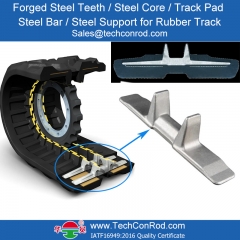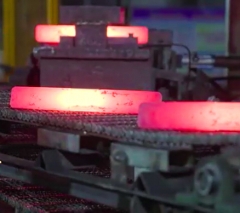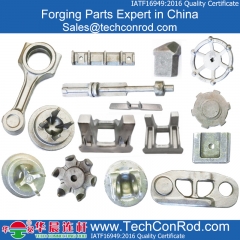 +86-151 9217 7108
+86-151 9217 7108
 +86-151 9217 7108
+86-151 9217 7108

High quality steel Die Forging parts with material 40Cr 42CrMo and C70S6
read more
High quality steel Die Forging parts with material 40Cr 42CrMo and C70S6
read more
High quality steel forging parts with material 40Cr 42CrMo and C70S6
read more
OEM high performance steel forging parts at China price.
read moreHot forging entails the heating of a workpiece to about 75% of its melting temperature. This allows for the flow stress and energy required to form the metal to lower, effectively increasing the rate of production (or strain rate). Hot forging aids in making the metal easier to shape as well as less likely to fracture.
Steel, along with its alloys, are almost always hot forged for two main reasons:
If work hardening progresses, hard materials (such as steel and iron) will become more difficult to work with, and It is a more economical option to hot forge metals such as steel and then follow with heat treatment processes as metals such as steel can be strengthened through other processes (and not necessarily just cold working processes).
While other materials need to be strengthened through the forging process itself, materials such as most of the titanium and aluminum alloys, can be hot forged and then then hardened.
Average temperatures for hot forging includes:
Aluminum (Al) Alloys - 360° (680°F) to 520°C (968°F)
Copper (Cu) Alloys - 700°C (1 292°F) - 800°C (1 472°F)
Steel - up to 1 150°C (2 102°F)
During hot forging processes, the temperature reaches above the recrystallization point of the metal being formed. Being a process in which metals are plastically deformed above their recrystallization temperature, these high temperatures are required in order avoid strain hardening during deformation.
This process usually involves heating the metal (to the above its recrystallization point) after which it is smashed into a die – depending on the requirements, this die can also be heated. Because the metal is hot, it ‘moves around’ easily and allows manufacturers to create more elaborate shapes than with cold forging.
With super alloys (which have low forgeability), processes such as isothermal forging - where deformation takes place within a controlled atmosphere - is used in order to avoid oxidation.
Isothermal forging, also know as hot die forging, is a hot working process which entails the workpiece being maintained at its maximum elevated temperature throughout the entire forming process.
Maintaining this temperature is done by heating the die - this will be at the temperature of, or slightly lower than the elevated temperature of the workpiece. Forces exerted by this die forms the workpiece and, because the die is also at an elevated temperature, cooling of the workpiece between the mold work interface is eliminated. This in turn results in an improvement of the metal’s (workpiece’s) flow characteristics.
Note here that isothermal forging can also be performed in a vacuum.
 online
online 0086-635-4560298
0086-635-4560298 0086-635-4560298
0086-635-4560298 info@techconrod.com
info@techconrod.com +86-151 9217 7108
+86-151 9217 7108